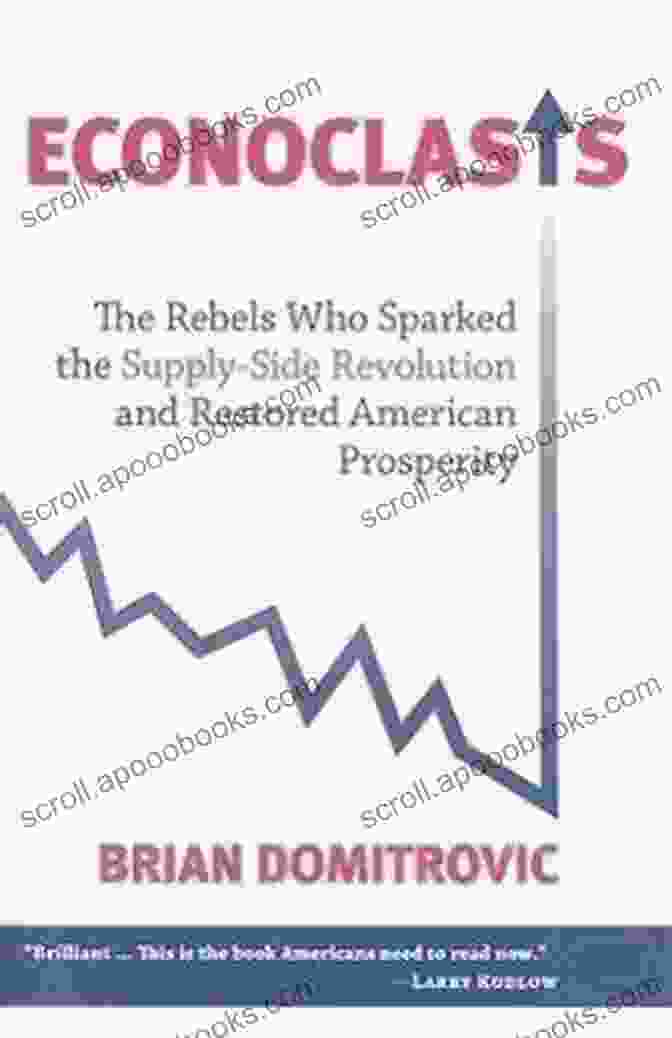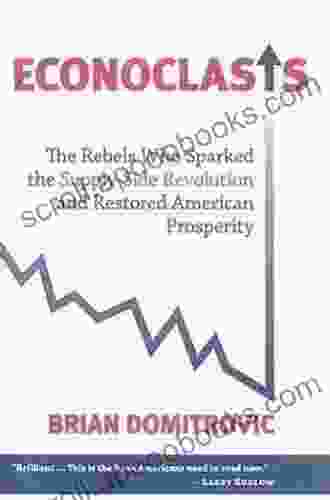The Rebels Who Sparked The Supply Side Movement And Restored American Prosperity

4.2 out of 5
| Language | : | English |
| File size | : | 794 KB |
| Text-to-Speech | : | Enabled |
| Screen Reader | : | Supported |
| Enhanced typesetting | : | Enabled |
| Word Wise | : | Enabled |
| Print length | : | 368 pages |
| Lending | : | Enabled |
| X-Ray for textbooks | : | Enabled |

In the 1970s, the American economy was in shambles. Inflation was rampant, economic growth had stalled, and unemployment was soaring. The prevailing economic wisdom of the time, known as Keynesian economics, had failed to address these pressing issues.
But a group of intrepid economists and policy advisors, known as the "Supply-Siders," emerged with a radical new approach. They believed that stimulating the supply side of the economy, rather than the demand side, held the key to unlocking economic prosperity.
The Birth of the Supply Side Movement
The intellectual foundation of the Supply Side Movement was laid by economist Arthur Laffer in the early 1970s. Laffer's famous "Laffer Curve" demonstrated that tax cuts could actually lead to increased government revenue by stimulating economic growth.
Jude Wanniski, a journalist and economic commentator, popularized Laffer's ideas and coined the term "Supply-Side Economics." Wanniski argued that reducing taxes would unleash the productive potential of individuals and businesses, leading to a surge in economic activity.
The Reagan Revolution
In 1980, Ronald Reagan ran for president on a platform that embraced Supply-Side principles. Reagan's election marked a watershed moment for the movement.
Reagan's administration implemented a series of bold economic policies, including tax cuts, deregulation, and reduced government spending. These policies sparked an economic boom that lasted throughout the 1980s and 1990s.
The Pioneers of the Supply Side Movement
The Supply Side Movement was driven by a group of brilliant and passionate individuals who believed in the power of free markets and limited government.
- Arthur Laffer: Economist and architect of the Laffer Curve.
- Jude Wanniski: Journalist and popularizer of Supply-Side Economics.
- Ronald Reagan: President who embraced Supply-Side principles and presided over an era of economic prosperity.
- G. William Miller: Federal Reserve Chairman who поддержал tax cuts.
- Malcolm Baldrige: Commerce Secretary who promoted deregulation.
The Impact of the Supply Side Movement
The Supply Side Movement had a profound impact on the American economy:
- Reduced taxes: Tax cuts stimulated economic growth and increased government revenue.
- Deregulation: Reduced government regulations freed up businesses to innovate and invest.
- Limited government spending: Restrained spending helped reduce inflation and balance the budget.
- Economic boom: The policies enacted by the Reagan administration led to a surge in economic growth, job creation, and increased prosperity.
The Legacy of the Supply Side Movement
The Supply Side Movement played a pivotal role in restoring American economic prosperity. Its principles continue to influence economic policy debates today.
The movement's legacy is one of innovation, courage, and the belief in the power of free markets. The rebels who sparked the Supply Side Movement left an indelible mark on the American economy, proving that even in the darkest of times, bold ideas can transform the future.
The story of the Supply Side Movement is a captivating tale of economic transformation. From the intellectual foundation laid by Arthur Laffer to the bold policies enacted by Ronald Reagan, the movement's impact on the American economy has been immeasurable.
The Supply Side Movement serves as a reminder that even in the face of economic adversity, innovative thinking and a belief in free markets can lead to unprecedented prosperity.
4.2 out of 5
| Language | : | English |
| File size | : | 794 KB |
| Text-to-Speech | : | Enabled |
| Screen Reader | : | Supported |
| Enhanced typesetting | : | Enabled |
| Word Wise | : | Enabled |
| Print length | : | 368 pages |
| Lending | : | Enabled |
| X-Ray for textbooks | : | Enabled |
Do you want to contribute by writing guest posts on this blog?
Please contact us and send us a resume of previous articles that you have written.
 Book
Book Novel
Novel Page
Page Chapter
Chapter Text
Text Story
Story Genre
Genre Reader
Reader Library
Library Paperback
Paperback E-book
E-book Magazine
Magazine Newspaper
Newspaper Paragraph
Paragraph Sentence
Sentence Bookmark
Bookmark Shelf
Shelf Glossary
Glossary Bibliography
Bibliography Foreword
Foreword Preface
Preface Synopsis
Synopsis Annotation
Annotation Footnote
Footnote Manuscript
Manuscript Scroll
Scroll Codex
Codex Tome
Tome Bestseller
Bestseller Classics
Classics Library card
Library card Narrative
Narrative Biography
Biography Autobiography
Autobiography Memoir
Memoir Reference
Reference Encyclopedia
Encyclopedia Betty Jean Craige
Betty Jean Craige Paul Barron
Paul Barron Billie Sue Mosiman
Billie Sue Mosiman Brandon Sanderson
Brandon Sanderson Colleen Hoover
Colleen Hoover Brenda Shaughnessy
Brenda Shaughnessy Crystal Dahl
Crystal Dahl Jacob Steinberg
Jacob Steinberg Krin Gabbard
Krin Gabbard Brian Meehl
Brian Meehl Lenny Duncan
Lenny Duncan Brian Herbert
Brian Herbert Brandon Stanton
Brandon Stanton Ross Jacobs
Ross Jacobs Brian Joseph Gilley
Brian Joseph Gilley Charles Murray
Charles Murray Bland Simpson
Bland Simpson Boaz Ganor
Boaz Ganor Bill Dodds
Bill Dodds Brenda Chapman
Brenda Chapman
Light bulbAdvertise smarter! Our strategic ad space ensures maximum exposure. Reserve your spot today!

 Guillermo BlairImmerse Yourself in the Epic Masterpiece: Anna Karenina Complete English...
Guillermo BlairImmerse Yourself in the Epic Masterpiece: Anna Karenina Complete English... Patrick RothfussFollow ·15.3k
Patrick RothfussFollow ·15.3k Heath PowellFollow ·14.5k
Heath PowellFollow ·14.5k Franklin BellFollow ·18.1k
Franklin BellFollow ·18.1k Deacon BellFollow ·14k
Deacon BellFollow ·14k Shannon SimmonsFollow ·10.3k
Shannon SimmonsFollow ·10.3k Douglas AdamsFollow ·8.6k
Douglas AdamsFollow ·8.6k Jeffrey HayesFollow ·6.9k
Jeffrey HayesFollow ·6.9k Carter HayesFollow ·2.4k
Carter HayesFollow ·2.4k

 Corey Green
Corey GreenHuman Geography: A Concise Introduction by Gilbert...
A Journey into the Dynamic Realm of...

 Julian Powell
Julian PowellTrain Your Mind to Make Great Art a Habit
Do you dream of...

 Matthew Ward
Matthew WardSmall Town Romance: Heart Compass
Escape to Willow Creek, Where...

 Neil Parker
Neil ParkerMusic, Social Media, and Global Mobility: Exploring...
: The Convergence of Music, Media, and...

 Seth Hayes
Seth HayesUnlock the Potential of Potential Theory with Brooke...
Embark on an...
4.2 out of 5
| Language | : | English |
| File size | : | 794 KB |
| Text-to-Speech | : | Enabled |
| Screen Reader | : | Supported |
| Enhanced typesetting | : | Enabled |
| Word Wise | : | Enabled |
| Print length | : | 368 pages |
| Lending | : | Enabled |
| X-Ray for textbooks | : | Enabled |












